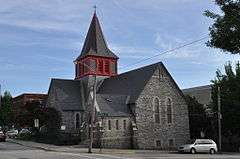Trinity Episcopal Church (Lewiston, Maine)
|
Trinity Episcopal Church | |
 | |
  | |
| Location | 247 Bates St., Lewiston, Maine |
|---|---|
| Coordinates | 44°5′37″N 70°12′46″W / 44.09361°N 70.21278°WCoordinates: 44°5′37″N 70°12′46″W / 44.09361°N 70.21278°W |
| Area | less than one acre |
| Built | 1879 |
| Architect | Haight,C. C. Co. |
| Architectural style | Gothic Revival |
| NRHP Reference # | 78000159[1] |
| Added to NRHP | March 30, 1978 |
Trinity Episcopal Church, now the Trinity Jubilee Center, is a historic church building at 247 Bates Street in Lewiston, Maine. It is a modestly sized yet handsomely decorated Gothic Revival building, designed by C.C. Haight of New York City and completed in 1882. It was operated as a church until 2001, when the diocese, faced with declining participation, transformed it into a community center. The building was listed on the National Register of Historic Places in 1978.[1]
Architecture and history
The former Trinity Episcopal Church building stands at the southwest corner of Spruce and Bates Streets in downtown Lewiston, just south of Kennedy Park. It is a single-story stone structure laid out in a cruciform plan, with granite walls and a slate roof. A square tower with a belfry and hipped spire rises at the center of the cross, and a secondary gabled entrance vestibule projects north from the rear of the nave. Windows are generally narrow lancet-arched Gothic windows, with circular rose windows in some of the larger gables.[2]
The Trinity Church parish was organized in 1854, and built its first dedicate sanctuary at Ash and Park Streets in 1859. After outgrowing that space, the parish built this church, on land donated by the Franklin Company. Construction took three years, and the building was consecrated in 1882.[2] The parish remained active for over a century, but declining participation prompted a decision by the diocese to close it, consolidating its membership with other parishes. Instead, the local minister broadened the church's mission to encompass more of the adjacent community, transforming it into a non-sectarian, non-religious service and community center. The Trinity Jubilee Center was formally organized in 2001.[3]
See also
References
- 1 2 National Park Service (2007-01-23). "National Register Information System". National Register of Historic Places. National Park Service.
- 1 2 "NRHP nomination for Trinity Episcopal Church" (PDF). National Park Service. Retrieved 2016-03-01.
- ↑ "About Us". Trinity Jubilee Center. Retrieved 2016-03-01.